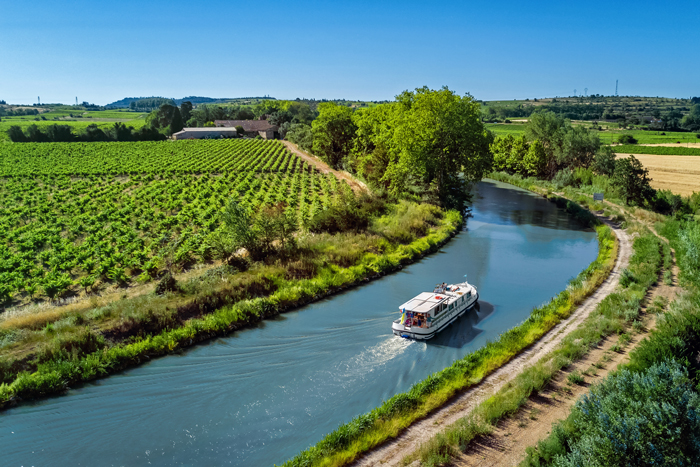A 17th-century architectural gem and UNESCO World Heritage Site, the Canal du Midi tells a story of engineering and perseverance. Today, this 360-kilometer French masterpiece invites travelers to a unique exploration of tradition and discovery, in the heart of Languedoc-Roussillon.
The Canal du Midi, a historic masterpiece
Built between 1667 and 1694, the Canal du Midi is a major achievement of the modern era and a turning point in the industrial revolution. This unique waterway bears witness to the genius of the designers commissioned by Louis XIV to link the Mediterranean and the Atlantic. Exceptional for its 360 km length and 328 structures (locks, aqueducts, bridges, weirs and tunnels), it was classified a UNESCO World Heritage site in 1996.
Behind the work, a man: Pierre-Paul Riquet
The highest point of the canal, at 189 meters above sea level, the Col de Naurouze posed a challenge for the water supply. In 1662, Pierre-Paul Riquet submitted his project to link Toulouse and Narbonne to Colbert, drawing on his excellent knowledge of hydraulics. He devised an ingenious system to recover water from the Montagne Noire and supply the canal with water all year round.
The Canal du Midi and Vauban
From 1685, the king asked Vauban to improve on Pierre-Paul Riquet’s work. A new phase of work began from 1686 to 1694, during which aqueducts, canal bridges and waterworks were built to evacuate overflows.
In 1787, a new branch line was built through Narbonne. This new junction would be linked to the sea by the Canal de Jonction, then at Sallèles-d’Aude, by the Canal de la Robine to Port La Nouvelle.
〉What you need to know〈
An unrealized project at Naurouze was the construction of an octagonal basin. Riquet’s ambitious plan to build a town here, including a commercial port and merchants’ offices, never came to fruition. In 1825, however, an obelisk was erected at Naurouze in tribute to Riquet.

Navigation and discovery on the Canal du Midi: a unique tourist experience
Originally intended for the transport of goods, the Canal du Midi reinvented itself with the decline of river transport. Today, it is a flagship destination for river tourism.
Structures to discover on the Canal du Midi
Among them, discover the barrage de Saint-Ferréol, the oldest reservoir (1667-1680), essential to the canal’s water supply.
Lac de Saint-Ferréol is a truly sumptuous lake in the Laudot valley. It occupies no less than 62 hectares. Since March 13, 1997, it has been protected as an historic monument. Popular for swimming, it also boasts the Musée du Réservoir, dedicated to the history of the canal.
Another emblematic site is the hamlet of Le Somail. Whether by boat, bike or on foot, you’ll love this stopover, with its bridge, inn and ancient buildings (up to 300 years old) bearing witness to life on the river in days gone by.
Discovery by boat
To fully appreciate the canal, navigation is ideal and accessible to all. Numerous rental companies offer boats (pénichettes) for 2 to 12 people, with no license required (maximum speed 8km/h). This crossing offers the opportunity to discover a timeless heritage, typical landscapes and charming villages, while savoring the gastronomy and wines of Languedoc-Roussillon in a friendly, peaceful atmosphere, far from the hustle and bustle of everyday life.




